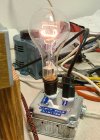I've got a 2009 JCM200 DSL100 (issue 20 main board) that suddenly lost all of it's volume. It's very faint on 10. During my troubleshooting I completed an insulation breakdown test and found the values all stayed very consistent. While doing that I found that the R9 resistor had burnt and also damaged the trace on the board directly under it. I removed the main board from the chassis, replaced the R9 resistor (you can see the new Grey one in the image) and bypassed the burnt trace with the black insulated 18ga solid wire you can also see in the image. It played well for a couple of hours then the R9 popped again.
I've been doing a lot of reading on this forum, but I can't seem to find this issue. I could use some help figuring out why the R9 keeps popping.
One thing I'm planning to try: I noticed that the Uxcell 1 ohm, 1W 5% Tolerance Carbon Film Resistors I ordered off of Amazon seem to have thinner conductor wires than the resistor that came off the board. It makes me think I was sent 0.5w resistors instead of the 1w I ordered. I ordered those specs because of what the Issue 7 schematic I have, told me it should be. (can't find an issue 20 schematic). Now, I've ordered some 1 Ohm Resistors, 3W 1% Tolerance Metal Film Resistors to put in this time. Am I way off with this? Is this a bad idea?
Not brand new working on electronics, first time troubleshooting an amplifier but definitely not new to troubleshooting problems. I'd appreciate any direction you all can give me!
Thanks!

I've been doing a lot of reading on this forum, but I can't seem to find this issue. I could use some help figuring out why the R9 keeps popping.
One thing I'm planning to try: I noticed that the Uxcell 1 ohm, 1W 5% Tolerance Carbon Film Resistors I ordered off of Amazon seem to have thinner conductor wires than the resistor that came off the board. It makes me think I was sent 0.5w resistors instead of the 1w I ordered. I ordered those specs because of what the Issue 7 schematic I have, told me it should be. (can't find an issue 20 schematic). Now, I've ordered some 1 Ohm Resistors, 3W 1% Tolerance Metal Film Resistors to put in this time. Am I way off with this? Is this a bad idea?
Not brand new working on electronics, first time troubleshooting an amplifier but definitely not new to troubleshooting problems. I'd appreciate any direction you all can give me!
Thanks!



